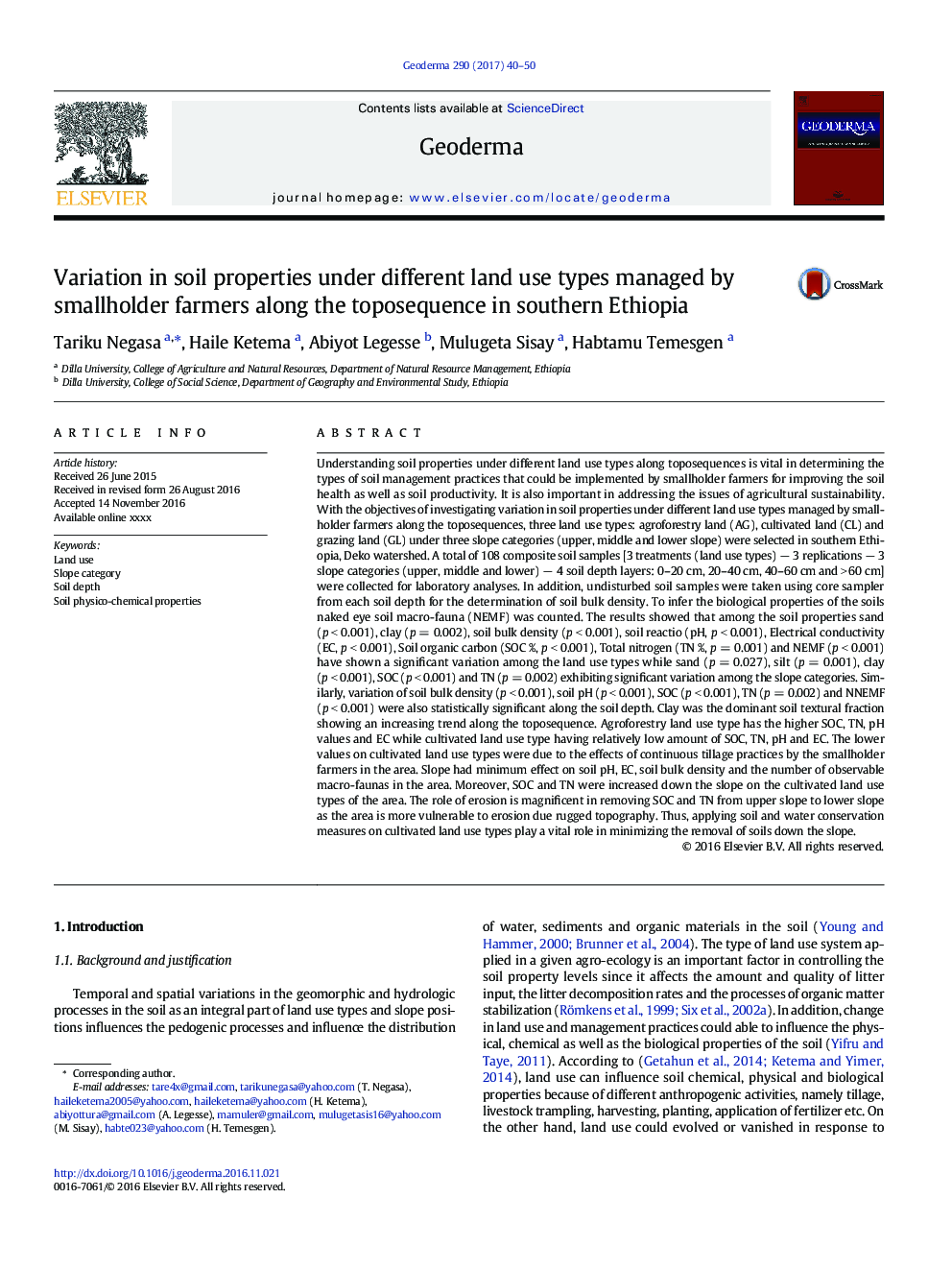| کد مقاله | کد نشریه | سال انتشار | مقاله انگلیسی | نسخه تمام متن |
|---|---|---|---|---|
| 5770425 | 1629427 | 2017 | 11 صفحه PDF | دانلود رایگان |
عنوان انگلیسی مقاله ISI
Variation in soil properties under different land use types managed by smallholder farmers along the toposequence in southern Ethiopia
ترجمه فارسی عنوان
تنوع در خواص خاک تحت انواع مختلف استفاده از زمین که توسط کشاورزان خرده مالکان در کنار زمین در جنوب اتیوپی اداره می شود
دانلود مقاله + سفارش ترجمه
دانلود مقاله ISI انگلیسی
رایگان برای ایرانیان
کلمات کلیدی
استفاده از زمین، رده شیب دار، عمق خاک، خواص فیزیکی شیمیایی خاک،
موضوعات مرتبط
مهندسی و علوم پایه
علوم زمین و سیارات
فرآیندهای سطح زمین
چکیده انگلیسی
Understanding soil properties under different land use types along toposequences is vital in determining the types of soil management practices that could be implemented by smallholder farmers for improving the soil health as well as soil productivity. It is also important in addressing the issues of agricultural sustainability. With the objectives of investigating variation in soil properties under different land use types managed by smallholder farmers along the toposequences, three land use types: agroforestry land (AG), cultivated land (CL) and grazing land (GL) under three slope categories (upper, middle and lower slope) were selected in southern Ethiopia, Deko watershed. A total of 108 composite soil samples [3 treatments (land use types) â 3 replications â 3 slope categories (upper, middle and lower) â 4 soil depth layers: 0-20 cm, 20-40 cm, 40-60 cm and > 60 cm] were collected for laboratory analyses. In addition, undisturbed soil samples were taken using core sampler from each soil depth for the determination of soil bulk density. To infer the biological properties of the soils naked eye soil macro-fauna (NEMF) was counted. The results showed that among the soil properties sand (p < 0.001), clay (p = 0.002), soil bulk density (p < 0.001), soil reactio (pH, p < 0.001), Electrical conductivity (EC, p < 0.001), Soil organic carbon (SOC %, p < 0.001), Total nitrogen (TN %, p = 0.001) and NEMF (p < 0.001) have shown a significant variation among the land use types while sand (p = 0.027), silt (p = 0.001), clay (p < 0.001), SOC (p < 0.001) and TN (p = 0.002) exhibiting significant variation among the slope categories. Similarly, variation of soil bulk density (p < 0.001), soil pH (p < 0.001), SOC (p < 0.001), TN (p = 0.002) and NNEMF (p < 0.001) were also statistically significant along the soil depth. Clay was the dominant soil textural fraction showing an increasing trend along the toposequence. Agroforestry land use type has the higher SOC, TN, pH values and EC while cultivated land use type having relatively low amount of SOC, TN, pH and EC. The lower values on cultivated land use types were due to the effects of continuous tillage practices by the smallholder farmers in the area. Slope had minimum effect on soil pH, EC, soil bulk density and the number of observable macro-faunas in the area. Moreover, SOC and TN were increased down the slope on the cultivated land use types of the area. The role of erosion is magnificent in removing SOC and TN from upper slope to lower slope as the area is more vulnerable to erosion due rugged topography. Thus, applying soil and water conservation measures on cultivated land use types play a vital role in minimizing the removal of soils down the slope.
ناشر
Database: Elsevier - ScienceDirect (ساینس دایرکت)
Journal: Geoderma - Volume 290, 15 March 2017, Pages 40-50
Journal: Geoderma - Volume 290, 15 March 2017, Pages 40-50
نویسندگان
Tariku Negasa, Haile Ketema, Abiyot Legesse, Mulugeta Sisay, Habtamu Temesgen,
